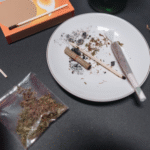
After spending over a decade researching cannabinoids and their effects on sleep, I still get this question almost daily: “Will hybrid weed make me sleepy?” The answer isn’t as straightforward as most people hope. As a cannabis researcher, I’ve seen firsthand how the same hybrid strain can have dramatically different effects on different people.
Let me walk you through what I’ve learned about hybrids and sleep, both from my work and from countless conversations with cannabis users.
What Makes a Cannabis Strain “Hybrid” Anyway?
Before diving into hybrids specifically, it’s important to understand the two parent types: Cannabis indica and Cannabis sativa. Traditionally, indicas are known for producing relaxing, sedative effects that create a physical “body high,” making them popular for nighttime use. Sativas, on the other hand, typically create energizing, cerebral effects that stimulate creativity and focus, making them better suited for daytime use.
Hybrid cannabis strains are crossbreeds between Cannabis indica and Cannabis sativa plants. Breeders specifically create these crosses to combine desirable traits from both parent plants, producing strains with targeted effects, flavors, and growth characteristics. While we often talk about “pure” indicas and sativas, the truth is that most modern cannabis strains have some degree of hybridization due to decades of intentional breeding.
What’s fascinating about hybrids is that they inherit characteristics from both parent strains. This creates a spectrum of effects rather than the oversimplified “indicas sedate, sativas energize” framework that many budtenders still use.
In my research, I’ve found that hybrids generally fall into three categories:
- Indica-dominant hybrids: These lean toward relaxation and physical effects
- Sativa-dominant hybrids: These tend toward cerebral, more energizing effects
- Balanced hybrids: These aim for equilibrium between body and mind effects
The Sleep Question: It’s Complicated
So will a hybrid make you sleepy? I wish I could give you a simple yes or no, but it depends on several key factors:
1. The Dominant Genetics Matter
In some studies, it is consistently found that indica-dominant hybrids are more likely to promote drowsiness. These strains often produce what patients describe as a “heavy body feeling” that can ease you into sleep.
One participant in a sleep quality study described her experience with an indica-dominant hybrid perfectly: “It feels like a warm blanket slowly covering my body from toes to head. My muscles unwind, and my racing thoughts finally quiet down.”
Sativa-dominant hybrids, on the other hand, typically produce more cerebral effects that can actually interfere with sleep. I’ve had research participants report racing thoughts or creative bursts after using sativa-dominant strains, which is not exactly conducive to falling asleep!
2. The Chemical Profile Is Crucial
The sleepiness question goes far beyond the indica/sativa classification. What really determines a strain’s effects is its unique chemical profile, specifically its cannabinoids and terpenes.
Cannabinoids
THC and CBD are the most well-known cannabinoids, but they affect sleep differently:
- THC: Can help you fall asleep faster at low to moderate doses, but high doses might increase anxiety and make sleep more difficult. This paradoxical response has shown up repeatedly in clinical studies and anecdotal reports alike.
- CBD: Doesn’t make you “high” but can reduce anxiety and pain, which are two common sleep disruptors. In our lab, we’ve observed that CBD-rich hybrids often improve sleep quality without the morning grogginess.
The “entourage effect” is also important to consider. This phenomenon suggests that cannabinoids work better together than in isolation, creating effects that neither compound could produce alone. For sleep purposes, a balanced THC:CBD ratio often produces better results than THC alone.
Terpenes
Terpenes are aromatic compounds found in cannabis and many other plants. While cannabinoids like THC and CBD receive most of the attention, terpenes play an equally important role in determining a strain’s effects. In fact, terpenes are largely responsible for why one hybrid might make you sleepy while another with similar THC content keeps you awake.
These aromatic compounds contribute significantly to a strain’s effects:
- Myrcene: Common in indica-leaning hybrids and has sedative properties. When a strain has more than 0.5% myrcene, it typically produces more relaxing effects. This is the most abundant terpene in cannabis and often the most influential for sleep effects.
- Linalool: Also found in lavender, this terpene has calming properties that can help prepare your body for sleep. It works directly on the nervous system to reduce anxiety and promote relaxation.
- Caryophyllene: Has anti-inflammatory effects that can reduce pain and help you fall asleep more comfortably.
- Limonene: Found in citrus fruits and sativa-leaning strains, this terpene typically produces uplifting, energetic effects that may interfere with sleep.
- Pinene: Has alerting properties and may counteract some of the memory impairment associated with THC, making it less ideal for sleep.
I came across a hybrid strain that, based on its genetics, should’ve been energizing. On paper, everything pointed to an uplifting effect. But its myrcene levels were off the charts, and the result was unexpectedly sedating. It was a perfect example of how chemical profiles consistently outweigh genetic lineage when it comes to predicting effects.
3. Dosage Makes a Huge Difference
In some clinical observations, dosage often determines whether a hybrid strain helps or hinders sleep. I’ve found that:
- Low doses tend to be relaxing without heavy sedation
- Moderate doses can be more sedating, especially with indica-dominant hybrids
- High doses can sometimes backfire, causing anxiety or discomfort that interferes with sleep
I’ve been particularly interested in microdosing, which involves using very small amounts of cannabis to achieve subtle therapeutic effects. Many research participants report that microdosing hybrid strains before bed helps them relax without feeling impaired or groggy the next morning.
4. Your Body Chemistry Is Unique
Perhaps the most frustrating answer I give to people is “it depends on your individual body chemistry.” But it’s true! I’ve seen identical twins respond completely differently to the same hybrid strain.
Factors that influence your response include:
- Your endocannabinoid system’s baseline function
- Previous cannabis experience and tolerance
- Metabolism
- Other medications you might be taking
- Even what you ate that day
Hybrid Strains That Might Help With Sleep
Based on both research and feedback from countless patients, these hybrid strains tend to be helpful for sleep:
- Granddaddy Purple: An indica-dominant hybrid with high myrcene content that consistently ranks high for sleep in our patient surveys.
- Wedding Cake: A balanced hybrid that many of my research participants report helps them fall asleep without feeling overly sedated. Its balanced cannabinoid profile and moderate myrcene levels make it popular for sleep without excessive grogginess.
- ACDC: A CBD-dominant hybrid that’s excellent for people who want sleep support without significant psychoactive effects.
- Northern Lights: An old-school indica-dominant hybrid that continues to be one of the most reliable sleep aids in our studies.
- GSC (formerly Girl Scout Cookies): An indica-dominant hybrid that combines euphoria with deep physical relaxation, making it effective for both mind and body relaxation before sleep.
- OG Kush variants: These typically provide a heavy body sensation while maintaining mental clarity, helping users wind down without feeling immediately knocked out.
I personally keep a small amount of Northern Lights in my nightstand for those occasional nights when my brain won’t shut off. A small amount about an hour before bed helps me transition into sleep without feeling groggy the next morning.
Hybrid Strains That Probably Won’t Make You Sleepy
For contrast, these hybrids typically don’t promote sleepiness and might actually keep you awake:
- Durban Poison: Despite being considered a “pure” sativa by many, it has some hybrid characteristics and is known for its energizing effects.
- Green Crack: A sativa-dominant hybrid that tends to increase alertness and energy.
- Tangie: A citrusy hybrid that most of my research subjects report as uplifting rather than sedating. Its high limonene content contributes to its energizing effects.
- Jack Herer: Named after the famous cannabis activist, this sativa-dominant hybrid is known for its clear-headed, creative effects that are not conducive to sleep.
If you’re looking to use cannabis during the day without drowsiness, these might be better options.
Finding Your Sleep Sweet Spot
After years of studying cannabis and sleep, I’ve developed some practical advice for those exploring hybrids for sleep:
- Start low and go slow: Begin with a minimal dose and gradually increase until you find your sweet spot.
- Timing matters: I’ve found that consuming cannabis 1-2 hours before bedtime works best for most people. This allows the initial cerebral effects to subside while the relaxing effects remain.
- Keep a cannabis journal: Track which strains, doses, and consumption methods help or hinder your sleep. This has been invaluable data in my research and helps patients find patterns.
- Consider consumption method: Different consumption methods affect how quickly you’ll feel effects and how long they’ll last:
- Inhalation (smoking or vaporizing): Effects typically begin within minutes and last 2-3 hours, making it good for falling asleep
- Edibles: Take 30-90 minutes to take effect but last 6-8 hours, potentially helping with staying asleep through the night
- Tinctures: Offer a middle ground with onset in 15-45 minutes and effects lasting 4-6 hours
- Combine with good sleep hygiene: Cannabis works best as part of a comprehensive sleep strategy that includes consistent sleep schedules and a comfortable sleep environment.
The Bottom Line
So, does hybrid weed make you sleepy? It can, especially if it’s indica-dominant with the right terpene profile, consumed at the appropriate dose for your body chemistry.
But there’s no one-size-fits-all answer. The beauty and challenge of cannabis is its complexity and the personalized approach it requires. What puts your friend to sleep might keep you wide awake.
In my years of research, I’ve come to appreciate that finding the right cannabis for sleep is both a science and an art. It requires some experimentation, careful observation, and a willingness to adjust based on your body’s feedback.
If you’re exploring cannabis for sleep, I encourage you to approach it with curiosity and patience. The right hybrid might just help you find the restful sleep you’ve been looking for, but it might take some trial and error to get there.
Frequently Asked Questions
Can smoking weed before bed keep you awake instead of helping you sleep?
Yes, it absolutely can, particularly if you use a sativa-dominant strain or consume too high a dose of any type. High doses of THC can trigger anxiety or racing thoughts that interfere with sleep. This is why finding your personal sweet spot is crucial.
Why does indica make me so tired while sativa doesn’t?
Indica strains typically contain higher levels of myrcene and other sedating terpenes, plus a cannabinoid profile that promotes relaxation. Your individual endocannabinoid system’s response to these compounds determines the intensity of these effects.
Is it bad to rely on cannabis for sleep regularly?
Like any sleep aid, regular use of cannabis can potentially lead to tolerance or dependence. Some research shows that long-term use may disrupt natural sleep architecture, particularly REM sleep. I recommend using cannabis as part of a broader sleep hygiene strategy rather than your only tool for sleep.
Will I feel groggy the next day after using hybrid cannabis for sleep?
This depends on the strain, dosage, timing, and your individual metabolism. Indica-dominant strains used in high doses close to bedtime are more likely to cause next-day grogginess. Starting with low doses and giving your body enough time to process the cannabis before morning can minimize this effect.





